This dude has skills. But can he putt? 🙂
The Head Nut
#0001
This dude has skills. But can he putt? 🙂
The Head Nut
#0001
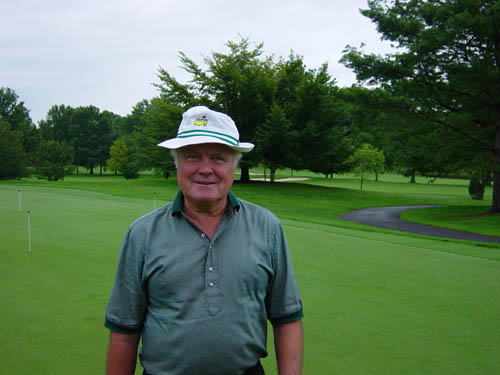
We lost Ed Heimann, Certified Golf Nut #2740 last August 1, 2021 at the age of 83.
Ed was famous in the Golf Nut Society for a couple of stupendous feats. First, his company, Globe and Hamilton Tailoring, were the makers of the Masters winners’ jackets, which earned him 2,000 Nut Points. Equally impressive was when he once hired David Leadbetter for a full week of all-day lessons when Leadbetter was at the height of his popularity, a rather expensive feat any measure! I guess #2740 wasn’t hitting it all that well and was kind of desperate. It earned him 5,000 Nut Points.
Following is an excerpt from Ed Heimann’s obituary:
“Globe and Hamilton Tailoring were manufacturers, representing dealers nationwide, of Fine Custom made suits, coats and uniforms. They sold Uniforms to the US Marines, US Air Force, Delta Airlines, Private Golf Clubs, and Police Forces across the country.
While Globe catered primarily to their dealers, and larger organizations, Ed was a gifted salesman and was able to convince many well-known individuals in the golfing world like Arnold Palmer and Greg Norman to appreciate Globe’s Garments. He also nurtured many celebrities like Perry Como, Bob Hope, Frank Sinatra, Glen Campbell, and Chet Atkins to be loyal customers.
Soon, not only were they customers of Globe but they became Ed’s friends. He often was invited to Palm Springs to play in the Bob Hope Classic and stay in Bob and Deloris’s home.
A recent article in Town and Country polled a number of athletes and asked them what they thought was the most coveted and well known award in sports. Overwhelmingly, they voted for the “Masters Green Jacket”, which was produced for more than 40 years at Hamilton Tailoring in Cincinnati.
Not only was Ed a gifted salesman, but also a master golfer. At a very young age he beat Jack Nicklaus at Avon Fields. He won the Club Championship at Hyde Park Country Club 26 times, the Club Championship at Coldstream Country Club 18 times, the Club Championship at Hammock Beach in Florida, and was a member of the Society of Seniors. He was also inducted into the Greater Cincinnati Legends of Golf.
Ed loved the game; he loved seeing others succeed at the game, and he inspired others to love it as much as he did.”
The Golf Nut Society celebrates Ed Heimann’s unmatched passion for the game, his great skill as a competitive golfer, and his endearing personality which made him a friend of the famous and not so famous throughout his life.
Rest in peace, #2740.
The Head Nut
#0001

For any Golf Nuts who don’t know what hole this is, it’s the 17th at Cypress Point.
What’s Your Favorite?
The Head Nut
#0001
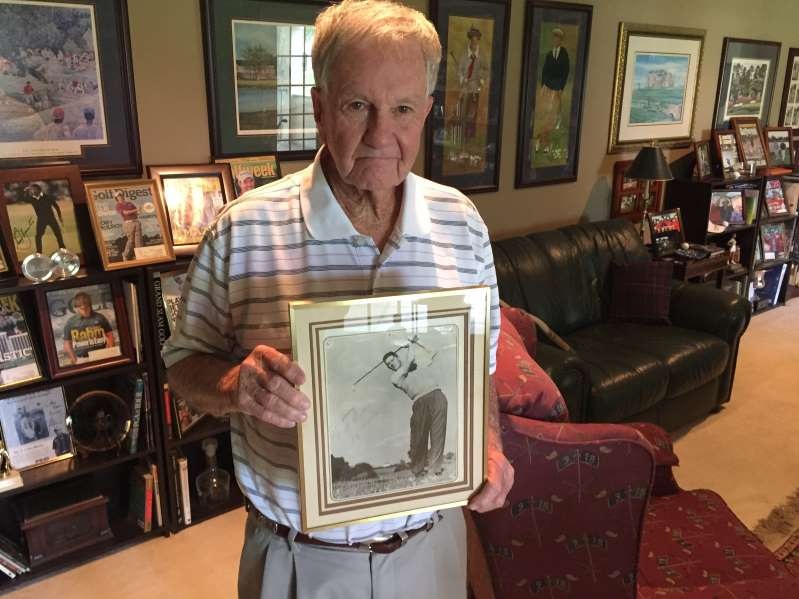
Dave Wells, Certified Golf Nut #2803, was named 2021 Golf Nut of the Year by the Golf Nut Society. Wells, a resident of Memphis, Tennessee, is the quintessential golf nut in every sense of the word. An excellent golfer who has played golf with numerous tour players, Dave is still an autograph hound and inveterate golf memorabilia collector. Nicknamed “Iron Byron” by none other than Julius “Dr. J” Irving for his uncanny accuracy off the tee, Dave has shot his age over 200 times, and every time he tees it up he is a threat to do it again.
He lives on the first tee of TPC Southwind, the home of the WGC-FedEx St. Jude Classic and can literally sit in his backyard and watch players tee off in the event.
He has played golf all across America and has attended numerous world-class PGA Tour events and Ryder Cups.
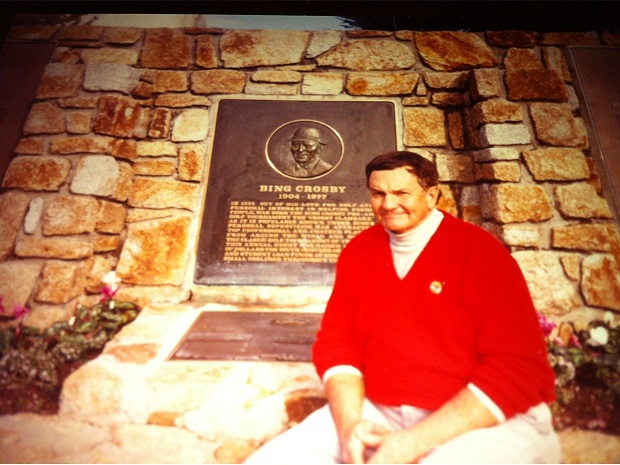
And then there’s his golf museum which takes up a large room in his home…
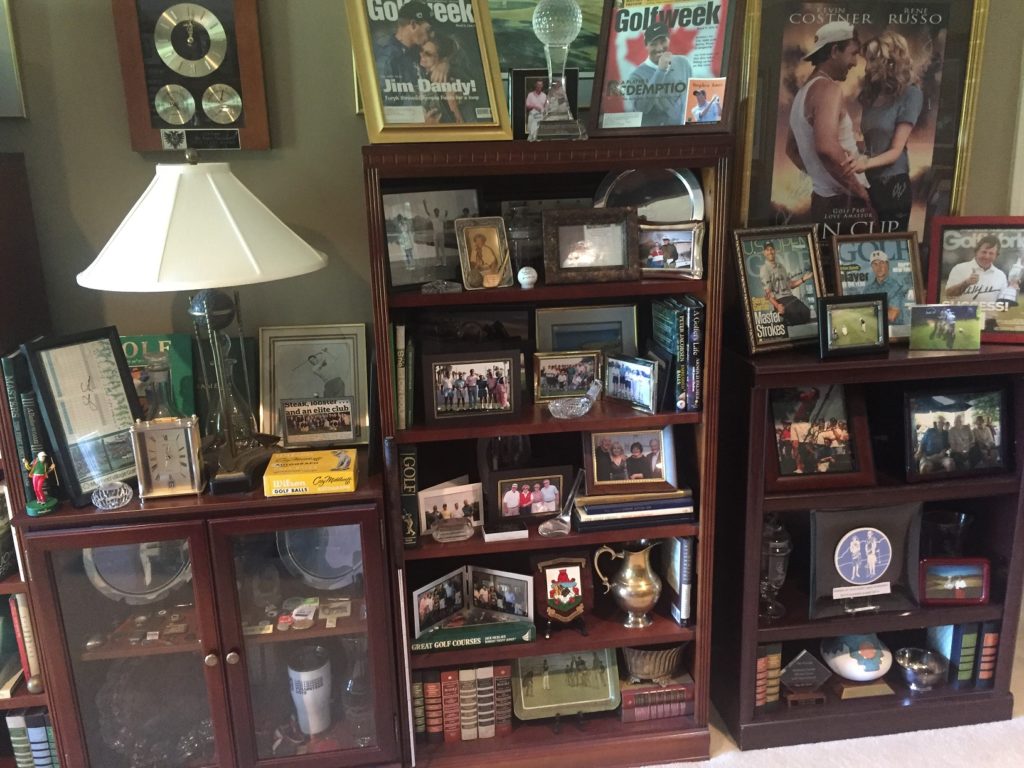
In winning the title, “Iron Byron” had an Entrance Exam score of 11,614 Nut Points, and 37,207 Bonus Points for a total of 48,821 Nut Points, placing him fourth on the All-Time Leading Scorers list.
An 84-year-old 10.6 handicap golfer, his lowest Index was 1.0, Wells is a long-time member of the Golf Nut Society and one of our favorites for his active involvement, great sense of humor, and unmatched passion for the game. Here are some of his more impressive feats:
BONUS POINTS SUMMARY
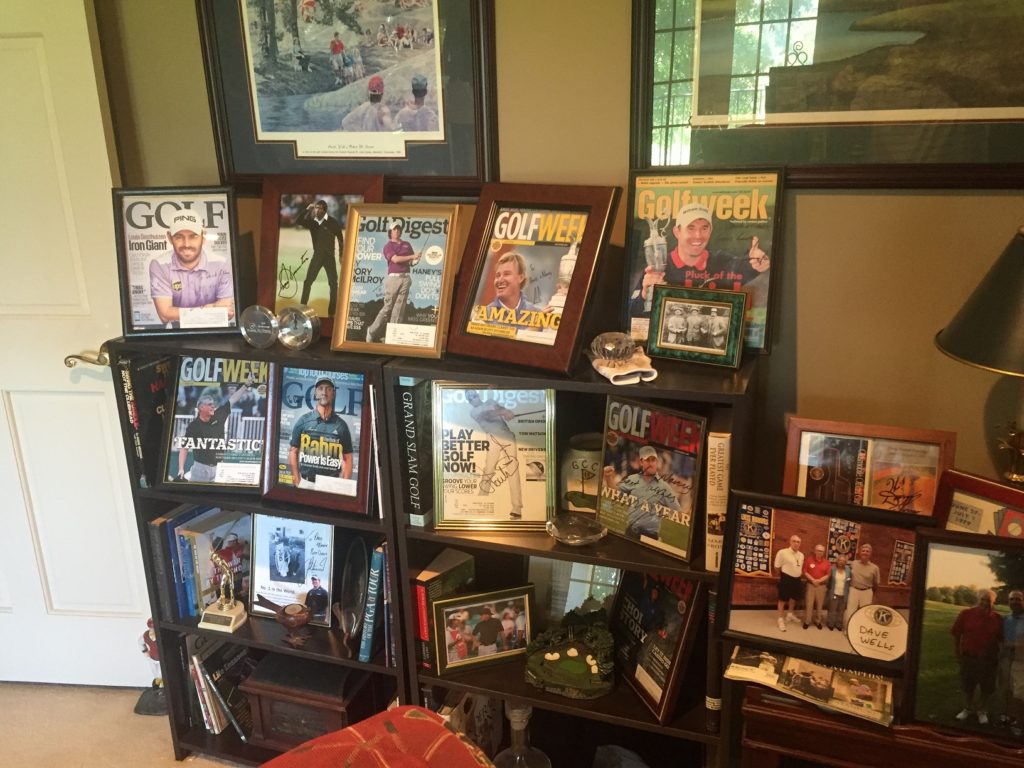
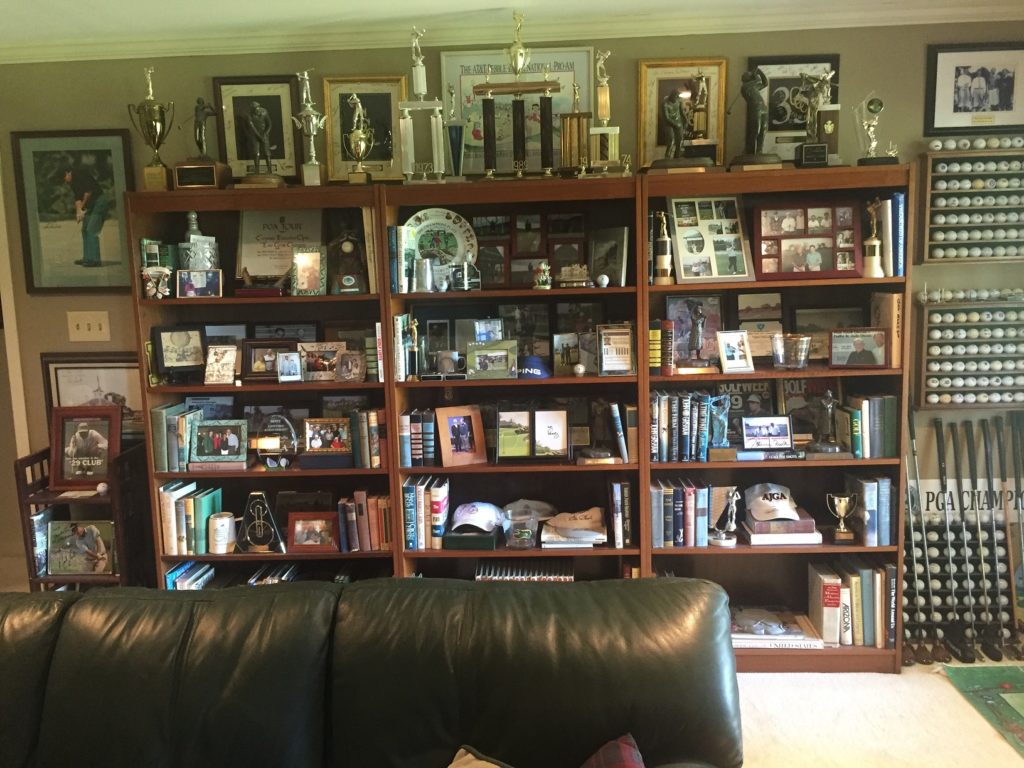
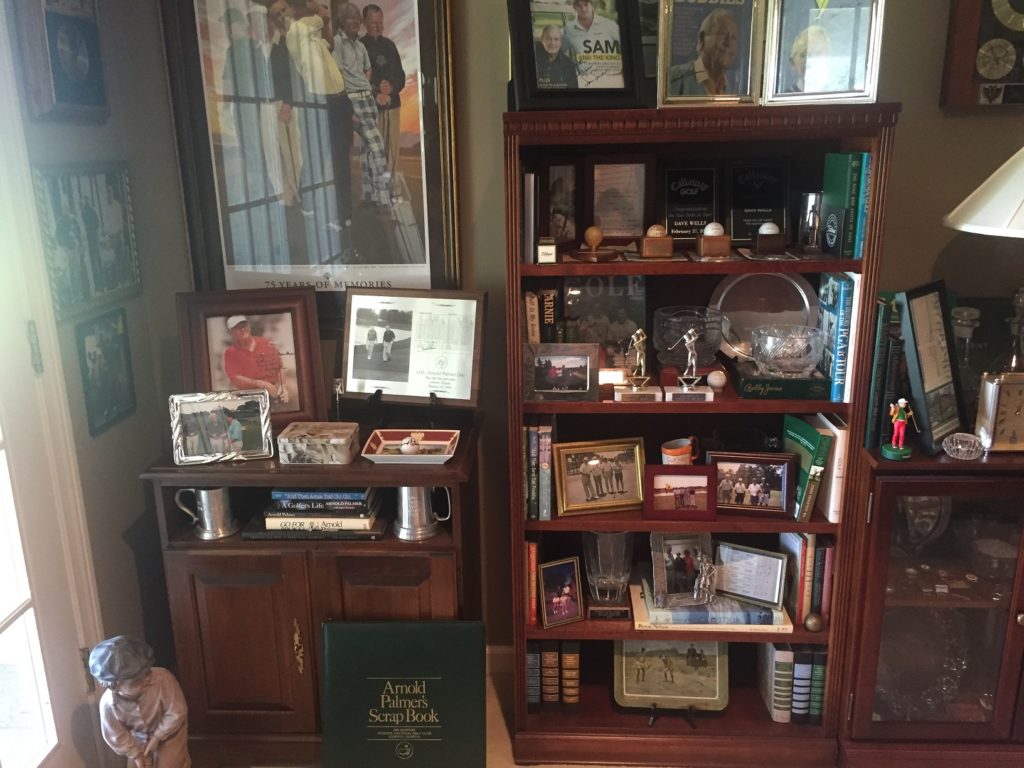
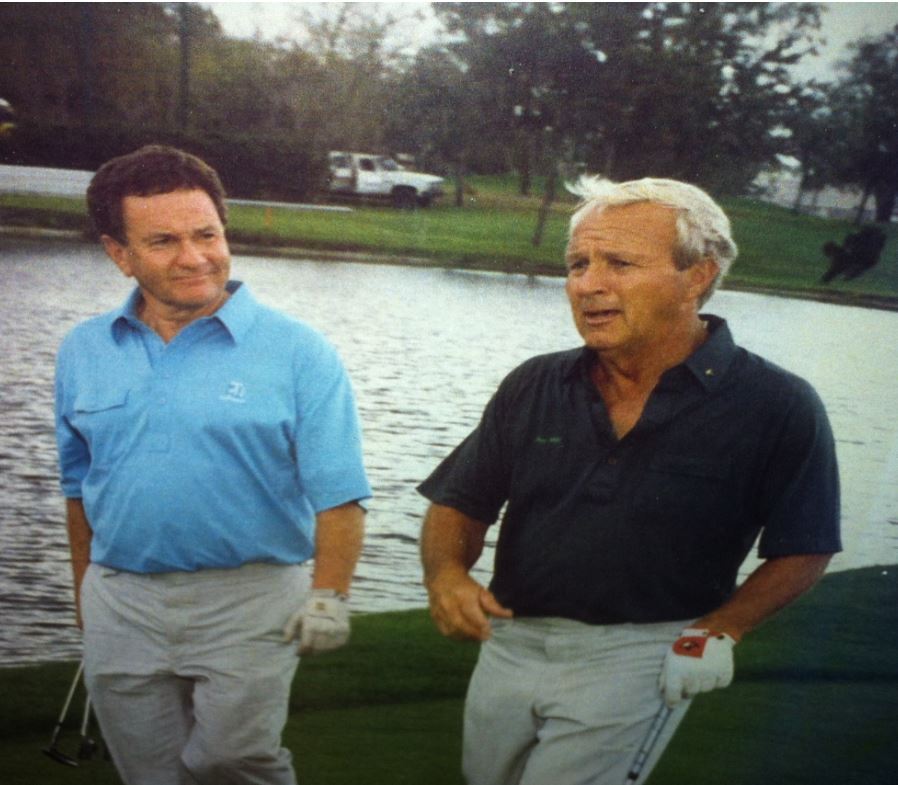
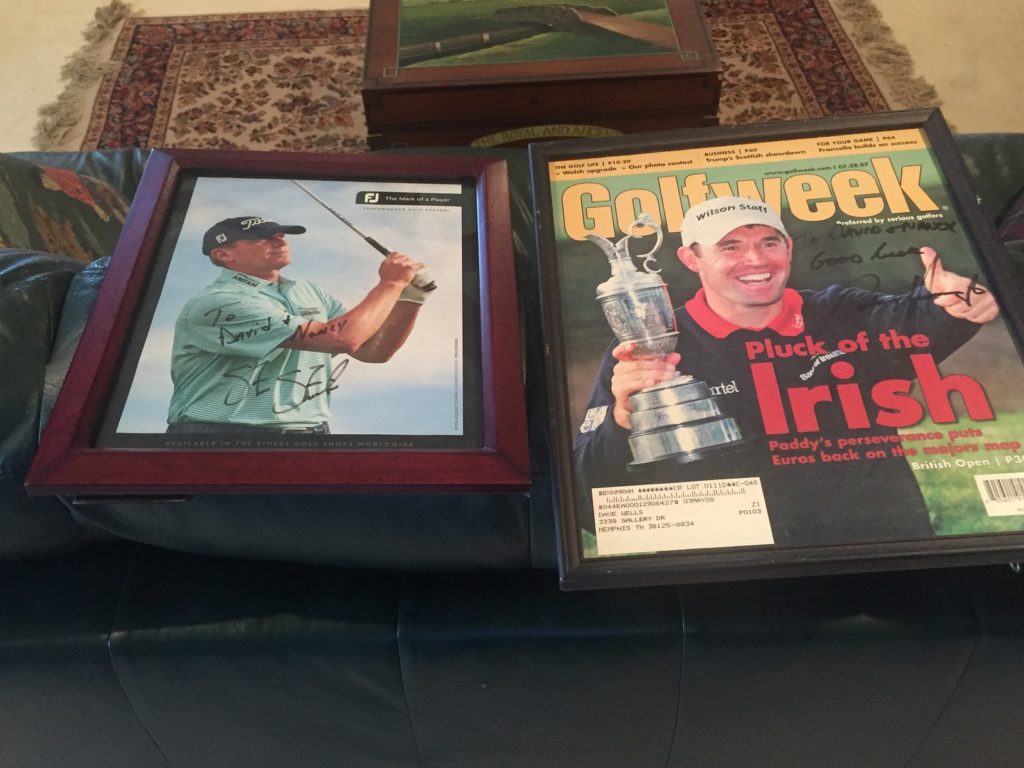
Last, but not least, Dave has his wife’s grandfather’s golf clubs from 1924 proudly displayed in his golf museum. They include six clubs (Jackson Park Driver not shown because shaft/clubhead were broken), five Irons (Mashie Iron, Mid Iron, 1-Iron, and two putters (one a Champion brand hand-made putter). Also in the bag were two Spalding golf balls and three short tees from that era. 600 Points
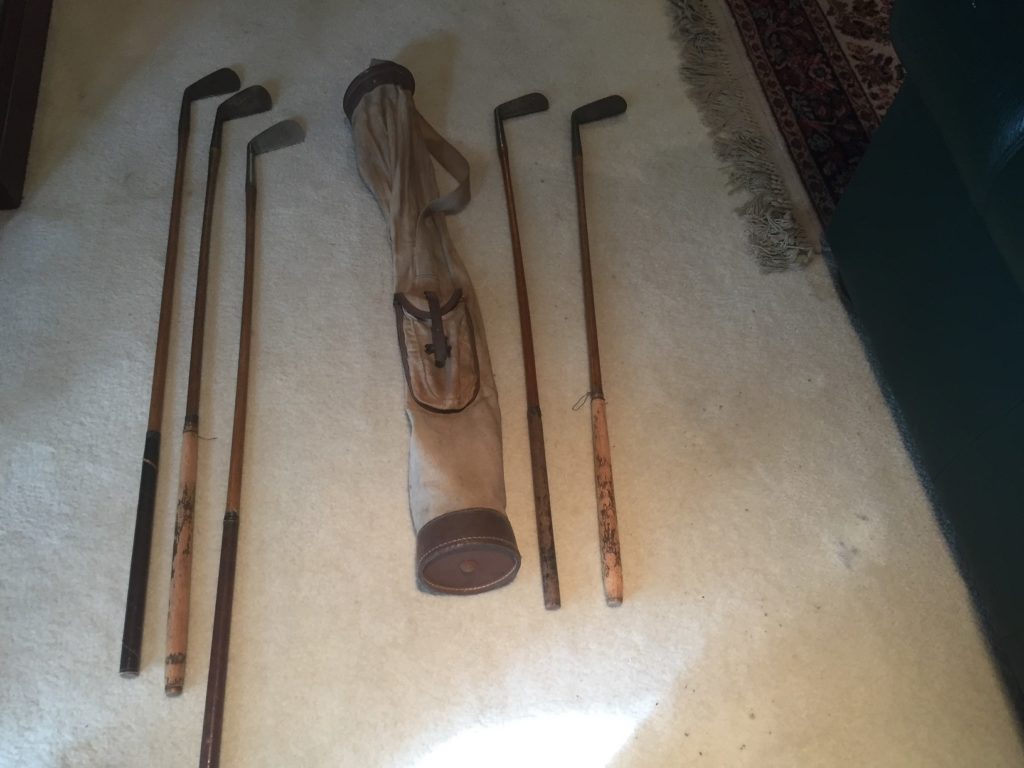
Dave Wells, Certified Golf Nut #2803, embodies everything that makes the Golf Nut Society what it is…a society for golfers who will never win a major, but who love the game with a passion that surpasses all understanding. We proudly celebrate Dave “Iron Byron” Wells’ victory! He is a worthy recipient of the title 2021 Golf Nut of the Year.
The Head Nut
#0001
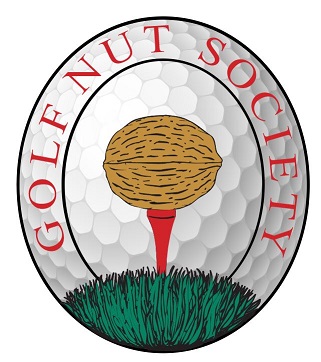
As we approach the day when we will name our Golf Nut of the Year, I thought it appropriate to honor the great achievements of a few of our past Golf Nuts of the Year. So let’s go, Nuts!

Bob Fagan (#3468) – 2003 Golf Nut of the Year & All-Time Leading Scorer
At the age of 51, he played 6 different 18-hole courses in 124 degree heat in Palm Springs in July in a single day. 624 Points
At the age of 48, he played 6 different 18-hole courses in 114 degree heat in Palm Springs in July in a single day, while walking and carrying his bag on three of the rounds. And on the sixth and final course, Tamarisk CC, he had no drinking water and the clubhouse was closed. “It was like the Burma Death March,” said Bob. 1,114 Points
And he survived to play another day. That’s nuts! – The Head Nut

Tom Jewell (#0175) – 1997 Golf Nut of the Year
Played golf on the first day of his honeymoon, April 8, 1956, at Locust Hill Country Club in Rochester, New York. There was snow on the ground, the temperature was a balmy 31 degrees, and his newlywed bride walked with him all 18 holes but didn’t play. 500 Points
Certified Golf Nut #0175 definitely married well! – The Head Nut

Howdy Giles (#2073) – 1994 Golf Nut of the Year
Howdy was Arnold Palmer’s dentist for many years, and when Arnie would come in to have his teeth worked on, Howdy would clandestinely scrape a small amount of gold from his fillings and tuck it away until he had enough to make a gold ball marker. When the top secret project was complete, he bought some black velvet, took the ball marker to the bank, rented a safe deposit box, and placed it on the velvet in the safe deposit box where it resides to this day. 3,000 Points
I think it’s safe to say that it is the only ball marker of its kind on Planet Earth. – The Head Nut
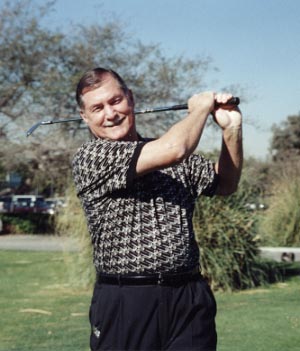
Mike Noyes (#2211) – 2000 Golf Nut of the Year
Mike spent nearly $10,000 to construct a 3-hole chipping and putting green in his backyard that he has dubbed “Dry Creek Golf Club.” It comes complete with a dry creek bed, tee markers, ball washer, yardage marker, club cleaner, sand trap rake and bar stools from the now defunct “Driftwood Golf Club” in Huntington Beach, California. 2,300 points
We lost Mike to The Great Fairway in the Sky several years ago but we still remember and honor him as one of our all-time greats. We miss you, #2211. – The Head Nut
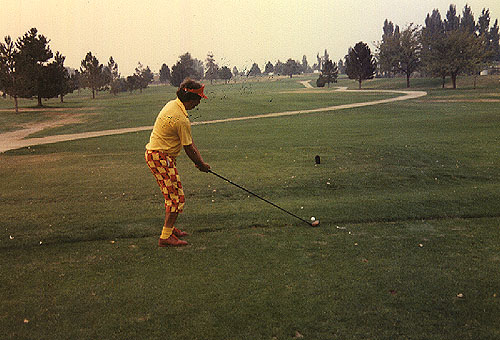
Joe Malay (#0020) – 1986 Golf Nut of the Year (Our first Golf Nut of the Year)
Joe Malay doesn’t have a job.. “Well, it’s a problem,” he says. “It would have a negative effect on my golf. You see, I love golf too much to work, and golf and work are incompatible. I love to play in golf tournaments, so that’s what I do. I plan to get a job when I’m too old to play golf.” His source of income? “To be determined at a later date,” says Joe. “I’m independently happy.”
Joe Malay has always marched to the sound of a different drummer. He lives in Weiser, Idaho, a small town in western Idaho, and everybody knows Joe. Well, except his wife, Mary. Joe isn’t home a lot during the golf season, so when someone calls and asks, “Where’s Joe?,” Mary replies, “I don’t know, let me check the IGA (Idaho Golf Association) schedule.” Every golf nut needs an understanding wife, but Mary breaks all the records.
Joe played in 53 tournaments in 1986, and the tournament season is only nine months long so that adds up to nearly six tournaments a month! In fact, he’ll often play in two tournaments on the same weekend, getting a morning tee time in one, and an afternoon tee time in the other. Joe gets in plenty of practice rounds too. He averages over 300 rounds of golf a year, and that’s done in only nine months, since it gets pretty cold in Idaho in the winter. If you run the numbers, you’ll see that Joe averages thirty-eight 18-hole rounds of golf a month! The final tournament of the year for Joe is the Pneumonia Open.
Speaking of cold weather, one bitter cold day in the dead of winter, Joe decided that he needed a round of golf to keep from going nuts. The temperature was 18 degrees, the wind was blowing 20 mph, the fairways, greens and water hazards were frozen solid, and the flagsticks were frozen in the cups. Joe shot an unbelievable 62 at Gem County Muni in Emmett, Idaho, and that was with a ball out-of-bounds on one hole!
There’s only one Joe Malay. His love of golf runs deep, and a round of golf with Joe is about as much fun as you can have on a golf course. – The Head Nut
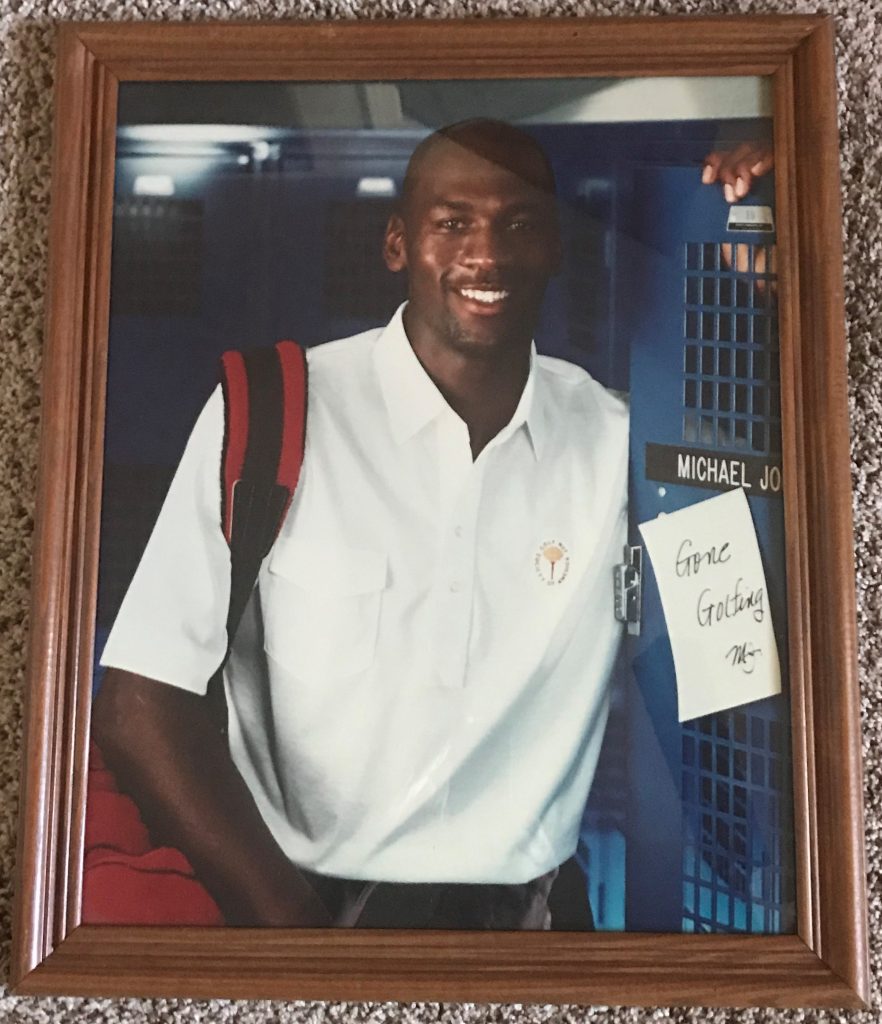
Michael Jordan (#0023) 1989 Golf Nut of the Year
When the 1993 All-Star Game was held in chilly Salt Lake City, MJ skipped “Media Day” and flew to Las Vegas with two other All-Stars to play golf at famous Shadow Creek. When asked why he flew to Las Vegas, he stated that the NBA should arrange to hold All-Star Games only in warm-weather cities so he could more easily play golf. 500 Points.
It is not wise to deny #0023 his appointed rounds. He will find a way to tee it up regardless the circumstances! We Golf Nuts are honored to have such a famous athlete and celebrity as a former Golf Nut of the Year. – The Head Nut
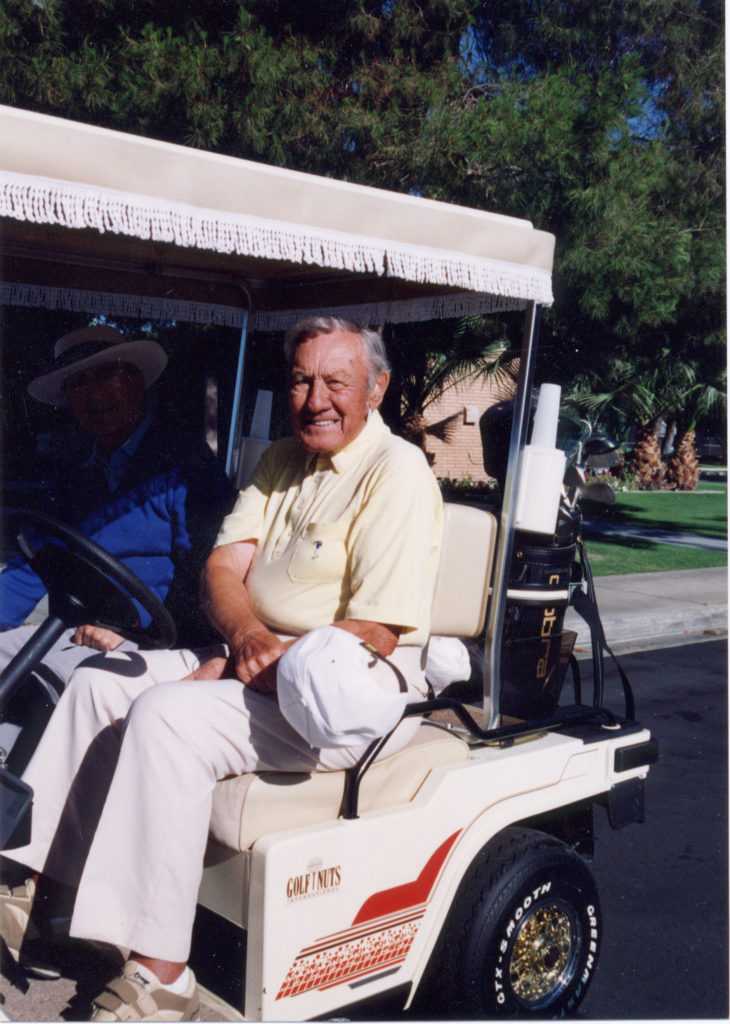
E.M. Vandeweghe (#1191) 1993 Golf Nut of the Year
He was practicing his swing one morning when he “got it!” His son (Ernie, Jr.) convinced him not to change his grip, and told him he would put the top down on the convertible and drive him to the golf course so he could try his new swing. They drove the two miles to the course with E.M. holding onto the club in the back seat, never once changing his grip. When he arrived at the course, Ernie, Jr. teed up a ball, and Dad took a swipe at it, shanking the ball into the pro shop. It was 7AM, and his hands had frozen on the drive to the course. 307 Points
This was clearly one of the great moments in Golf Nut history. E.M. was a legend at his home club and in the Golf Nut Society. He loved golf and we loved him. Rest in Peace, #1191, you are truly a legend who will live forever. – The Head Nut

Scott Houston (#1186) – 2002 Golf Nut of the Year
While caddying for Arnold Palmer at Pebble Beach, he pocketed a divot taken by Arnie on the 18th hole, took it home, and planted it in a flowerpot. For several years, #1186 cultivated it, even feeding it Coors Light at times. He would take it with him when he went to the range to practice, and even took it out for Sunday drives in the country so “Arnie” (Yes, he named it “Arnie”) could get some much-needed sun. It was such a compelling story that one filmmaker featured Scott and “Arnie” in his documentary entitled Golf: The Ridiculous Obsession. You can view the video HERE. 5,000 points
One of my all-time favorite Golf Nut stories, and #1186 is one of a kind. In fact, that begs the question, What kind of mind thinks of such things? – The Head Nut

Charlie Madge (#4025) – Our reigning Golf Nut of the Year!
At last count, the inimitable, irrepressible, Charlie Madge had made 3,001 four-footers in a row on his putting mat. I’m sure the count is higher by now, and that’s just the tip of the iceberg when it comes to Bonus Points. You can check out the rest of #4025’s accomplishments HERE. They will blow your mind!
3,001 four-footers in a row! Who does that?? Answer: A Certified Golf, that’s who. – The Head Nut
Well, I hope you enjoyed our trip through the past. Now you know why every Certified Golf Nut has a Nut #. That way it’s easier for the authorities to round them up and take them to the funny farm if they go over the edge.
The Head Nut
#0001
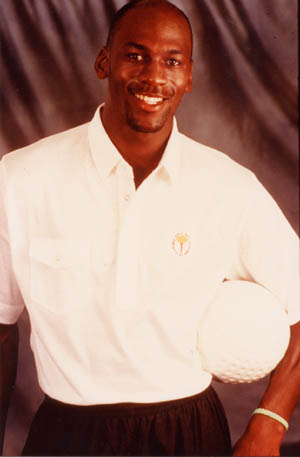
As we approach the end of 2021 and prepare to name our Golf Nut of the Year, I thought I would share with you how Michael Jordan, #23 for the Chicago Bulls, became a member of the Golf Nut Society and Certified Golf Nut #0023.
In short, it was a huge stroke of good fortune. A dear friend, Peter Moore (#0002), and I played golf every weekend in our regular foursome. At the time, Peter was the Worldwide Creative Director for Nike. It was his job to create an image – a marketable brand – for the athletes who signed with Nike.
When Michael signed with Nike, Peter and his team met with Michael whenever he came to town for brand and shoe design discussions. They did have one minor problem with Michael. He told Peter he was only good until Noon each day, after which he was going to play golf the rest of the day.
Peter called me one day and asked if I would like to join Michael and him for a round of golf. It was the easiest decision I’ve ever made. We had a great time, and at the end of the round, as we stood on the 18th tee, Peter said to Michael, “Ron has a club you might be interested in.” Michael replied, “What kind of club?” He thought Peter meant a golf club you swing, not a golf club you join, so I chimed in and said, “The Golf Nut Society of America.”
“What kind of club is that??” he asked. So, I explained it to him, and he said, “You don’t understand, you have to pay me to join your club.” And I replied, “You don’t understand, I can’t afford you.” He laughed and said, “Give me the information and I’ll check it out.”
This was the summer of 1986, and I had just founded the group a month earlier. Fortunately, I still had Nut #0023 available, which was yet another stroke of good fortune. One thing led to another. Michael liked the Golf Nut Society and the idea of being a Registered Golf Nut (Now Certified Golf Nut), and joined, becoming Nut #0023″.
Over the next three years, whenever Michael visited Nike, Peter would ask me to pick him up at the office and take him to our club to play golf. We would play until dark unless he was in town for a game. On those days, we would limit the fun to only eighteen holes. Each time we played, I would ask, “What have you done to earn Nut Points since we last played?” His obsession for the game was truly amazing. He racked up a ton of Nut Points.
In the summer of ’89, as we were playing, I said, “You know, Michael, you are now in 3rd place for Golf Nut of the Year. If you will finally take the Entrance Exam, you could win the title this year.” That’s all he had to hear. “Give me the exam and I’ll mail it back to you. I’m gonna win it,” he replied.
And he did win it. Michael took the exam on his return flight, put it in the mail, and sent it to GNS headquarters. His Entrance Exam score, added to his massive Bonus Points, put him at the top of the rankings for the year. At the end of the year, he was named 1989 Golf Nut of the Year, and received worldwide publicity for the win. Needless to say, it put the Golf Nut Society on the map and gave us a lot of credibility.
Meeting Michael Jordan, when he was at the peak of his fame was an incredible journey. I get into more detail about our relationship in my book Golf Nuts – You’ve Got To Be Committed, but as I look back, there were many great moments.
Perhaps the most memorable for me occurred after I had moved to the Phoenix area. Prior to the Bulls’ game six win in the NBA Finals to clinch the title, I called MJ’s office and told his assistant that I now lived in the Phoenix area, and that if he would like to tee it up, I was a member of a private club where he would be allowed to play golf in complete privacy. Michael called me the day before the game and said, “Let’s do it!”
We played 36 holes that day, 18 holes before his practice session, and 18 holes afterward. In the afternoon, two Golf Nuts – Ken Kellaney (#2020) and Duke DeBernardi (#0889) – joined us, and MJ won all the money, a foreboding of things to come on the basketball court for the Phoenix Suns.
The next day, Michael Jordan (#0023) won the NBA title.
Great memories.
Thank you, Peter Moore.
The Head Nut
#0001
P.S. Michael has his own dedicated page on our website. You can find it here.
If you can gain access to this…
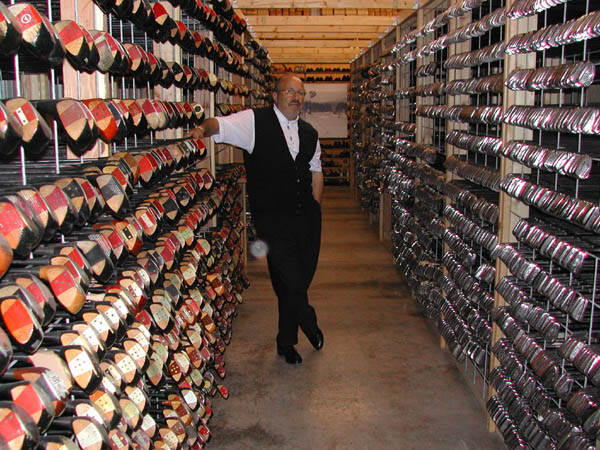
You are one very special Golf Nut because you know this guy…
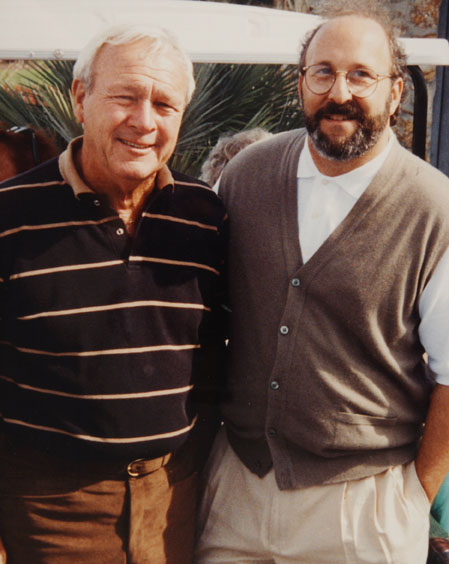
Yes, The King himself.
That’s Dr. Michael Cohen, and he is standing in the warehouse where Arnold Palmer stored every golf club he ever owned.
It simply doesn’t get any more special than that, and it earned “Doc” (Nut #2780) 5,000 Nut Points.
Well done, #2780!!
The Head Nut
#0001
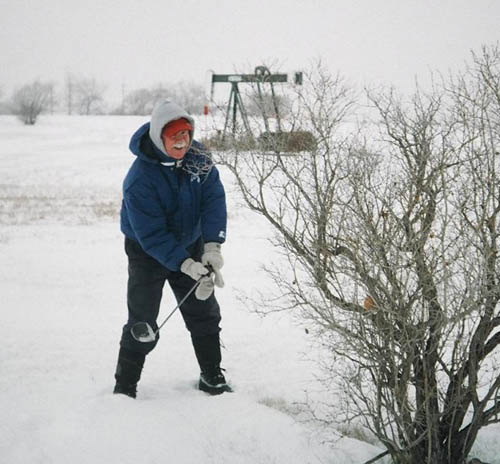
No, that’s not me…I’m not quite that nuts!
The Head Nut
#0001
Certified Golf Nut Bob Scavetta (#1696) sent the following photo to me, The Head Nut (#0001), and asked if that was my car he saw in the parking lot at Hudson Hills Golf Course recently…
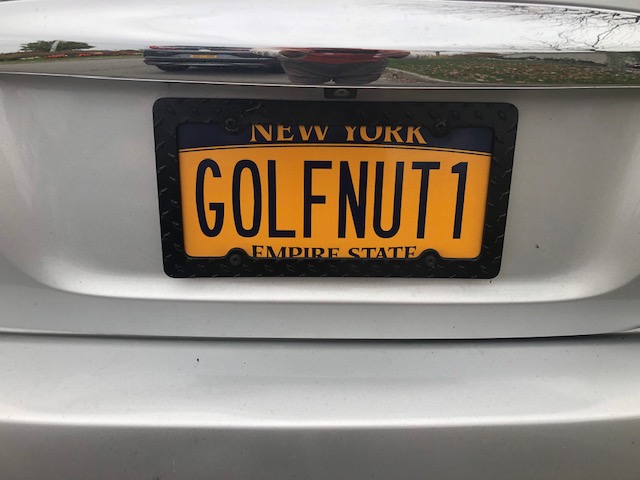
Sadly, I had to inform him that it wasn’t me as I don’t live in New York. But if I did, I would love to have that license plate!
The Head Nut
#0001